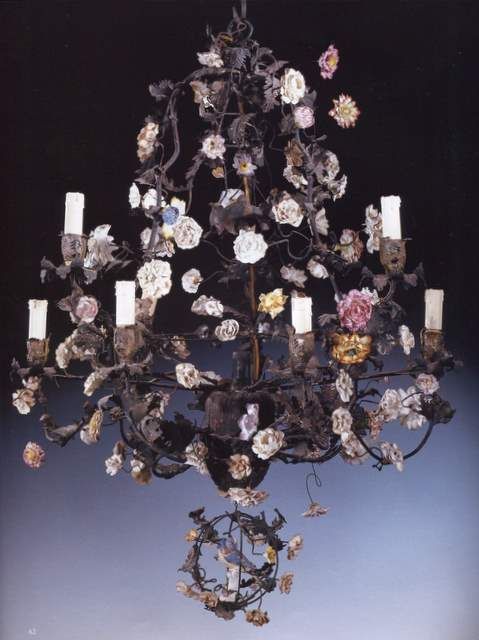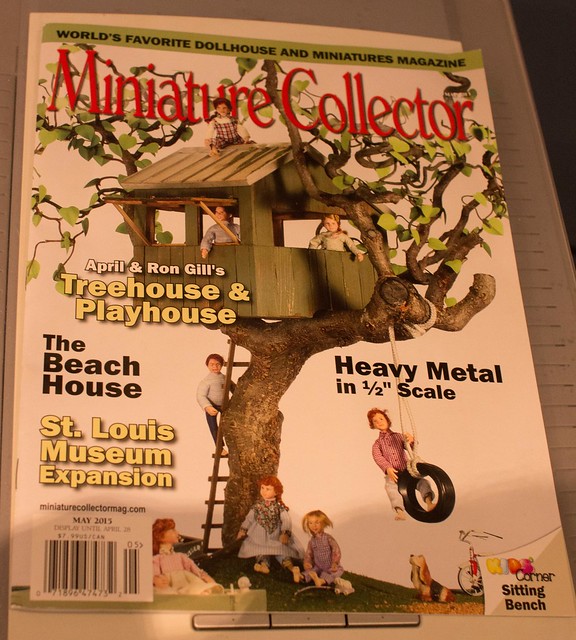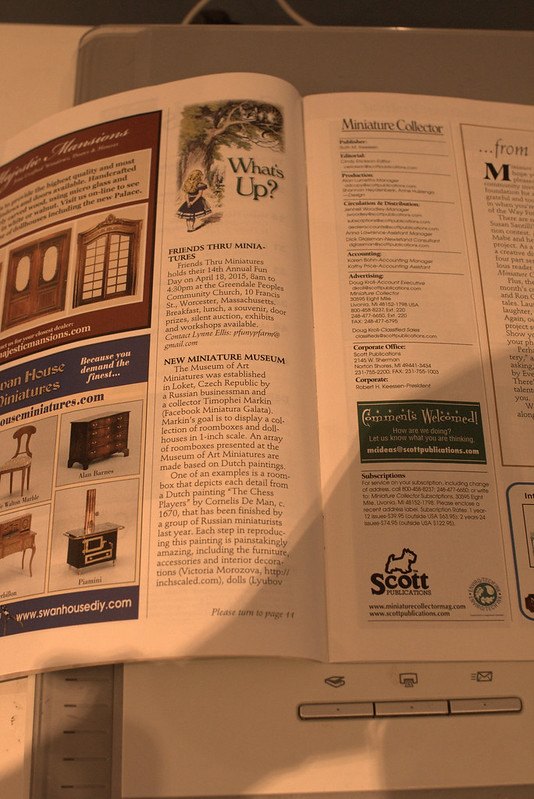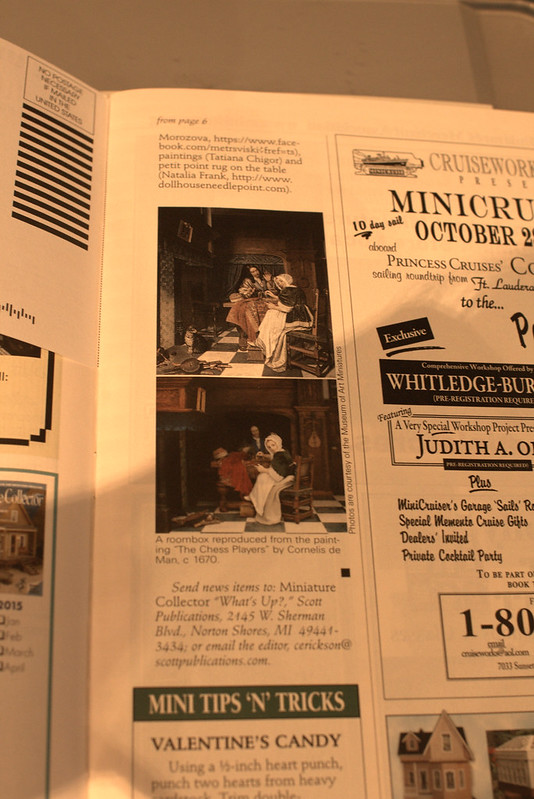Miniature Collector
Surprise, surprise! The roombox in the latest issue of Miniature Collector:
Third publication, first in US. As for me, I’m still sort of struggling with my marquetry project, I’m on Hinges stage right now, but the progress is slow due to real life things. ((
Cornelis De Man Chess Players Roombox.
Well, it’s all done, I’m waiting for the last third painting – the frame for it is ready. Here is the original painting:

And what we’ve done with it 🙂
Roombox. The Rug.
Another portion of the photos – this time about the rug. I’m not an expert in petit point, so when I started working on a project I decided that the rug should be commissioned to someone who’s the best at petit point. It was very important because even the back of the rug should have been perfect. And of course I was looking for someone who could chart the rug, find just the right colors, add the right mood to the whole picture. I immediately thought of Natalia Frank, I had no doubts she would do it perfectly. Natalia made several posts about this amazing rug – here, here, and here and here.
But I should add some personal thoughts about it – to see such beauty on the monitor is absolutely nothing, you should see it yourself, touch it, feel it, admire it. Natalia is a genius, I was blown away by all the details. The colors – perfect, just what I was looking for. We were all worried about the result, because we all have different monitors, so it was hard to say, how it was going to be, but here we are.
Roombox
I was going to write this post later next month, but I’m happy that I’m doing it now. All these months I was posting pictures of the furniture I made for the commissioned roombox and now I can show much more. Here’s a teaser:

New commission – table WIP
As a part of the commission I had a table. Now it’s a good time to show you a couple of photos of the process of making it. Initially I was going to use mahogany for it and even made a table top and blanks for the legs, which I’ll show you below, but later on the plans got changed and I remade everything from cherry wood. Don’t be surprised 🙂
Commissions and new router fence.
Some time ago I made a post about a router and a self-made wooden fence for it, (it was three years ago, time flies!) Well, not much has changed since that time, the only thing that became worse, was the fence itself. In the place where the fence and the router bit meet you could see uneven ends. So when you were working with tiny moldings, the accuracy of the the work suffered very much. My husband offered me to make a metallic fence for the router, and here’s the result:
It’s a bit taller than the wooden one, but you can change the width of it, so you can fit any router bit neatly. The view from behind, it’s very easy to remove it.
Making lighting for roombox
Remember that art nouveau roombox that I made some time ago? It was sold but came back to me, because I was asked to make lighting for it. That flower chandelier was made especially for this room. I also needed to make that Tiffany table lamp functional. I decided to try LEDs for this project. They are much brighter and don’t burn out as often as usual bulbs. I was looking for warm light LEDs for quite a while, and I was lucky to find very small (5 or 3mm, I don’t remember) and very cheap ones. So the first problem was solved.
The only problem with LEDs is that you have to find appropriate resistors, so say hello to physics course at school you hated so much. Ohm’s law – I had to look it up in Wikipedia for the first time in so many years. I had the resistors I needed but all this counting, colour code etc. was a bit too overwhelming to me. My husband though was curious enough to find a good video about so called LED drivers that would eliminate my problem with resistors. Here it is – http://www.chipdip.ru/en/video.aspx?vid=ID000306334. To make it easier for you, these LEDs drivers provide constant current of 20 mA in a circuit (most LEDs that I have are 20 mA), so you don’t need to count anything just connect this driver to a simple circuit. It’s very small by the way:
From the left to the right – small case for three drivers, driver itself and driver with small pins to make the soldering easier. So if you lazy to learn all this Ohm’s magic, drivers will save a lot of time for you.
For my chandeliers I used three LEDs, they are very small, so it wasn’t a problem.
One more chandelier
Last time I posted the frame and some flowers for a chandelier, this time the process of soldering:

I made the roses and leaves with polymer clay, every flower is attached to copper wire. To cover soldered spots I used acrylic paste.
Here is the result:
I totally forgot to show you the original chandeliers that inspired this work. Actually, I saw a lot of them in different antiques catalogs, usually French. But recently I found some Spanish chandeliers, also very beautiful. I also found that some were made with porcelain flowers, some with glass, some flowers were made of copper and brass. Also I saw all kinds of shapes and colors. Just perfect for me !:) Usually I see such chandeliers called Louis XV-style.
Here’s one of the chandeliers I found:

A bit too dark for me, to be honest, but lovely.
I decided to make a central lamp out of bead:
My first choice was the pink one, but later I found that it was too dark for my LED lamp. So I took transparent one.
It was worth it:
And as I used LED light, you can see that it shines only in one direction. Not really good for a room.
So I decided to try this lifehack – super glue and a bit of tin foil. You glue it to the tip of the lamp and here it is – the foil reflect the light, so it looks much better now. You can see by comparing previous photo with the one below. Obviously, the room is darker than it looks on the photo, but the direction of light is well seen. Maybe it’s just my perception, I don’t know 🙂
One more photo:
And about LED lamps, usually I don’t like them at all, most of them give this cold white light, that looks awful. I found some with warm white light, but they were a bit too big for using in miniature. So my husband suggested that we could buy LEDs with wave length= X-0.33. Y-0.36. Don’t ask me what it means 🙂 It’s all my husband ideas, he suggested that such LEDs were neutral white, not cold white. And I think he was right, the one in photos looks “warmer” to me than the ones I have. These LEDs are 5mm diameter.
I liked the result – so I think I’ll keep on looking for small warm-white LEDs.
Window – playing around
thought I would never post the parts I was just playing with, but never say never.
Last two days I was trying to find a design for the window, I looked through several books in Russian concerning modern style and also several Flickr groups. Result – hundreds of photos saved, basic concept was chosen.
The walls in my roombox are 1cm thick, so I decided to use walnut, just because it perfectly matched my pattern. It was 2,5mm thick, and I made some mistakes: first of all, I glued the pattern against the grain (hope it’s the right term), and secondly, the walnut I was using was too fragile, and IMO was overdried.So the window was “broken” – it just fell apart. Why, why did I do all this? I have no idea, I knew it wouldn’t work. Besides, I don’t have experience working with walnut, maybe you know – is it the material I’m using or is it about walnut itself? Instead of trying to fix it I decided to use mahogany – I worked with it when I was building the table, so I knew what to expect. And, no surprise, it was okay. I’ve managed to cut the whole window, this time the pattern was along the grain (hope that was my main mistake).

I’m not going to use this frame – now that I know that mahogany is my choice, I’ll start all over and cut the details separately, after that assemble.I need two frames, so it’s a lot of work:)
As you can see, I’m making it in art nouveau style, I feel so nervous about it, this should be my first time experience, and I’m not sure about the result. Hope I’ll make it work.
 Русский
Русский  English
English 

